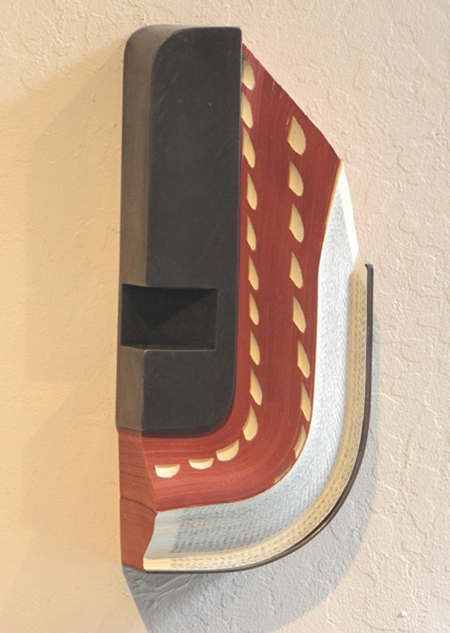
Continuing through March 2, 2014
With the digitization of publishing now established fact, and the five-century marriage of ink and paper coming apart, the sculptures of Andrew Hayes, which repurpose printed pages with elegant wit and stunning craftsmanship, could not be more timely. Art books, of course, are likely to survive Internet miniaturization; these works show that book art (of the kind that this gallery has long supported) will, also.
Hayes’ current exhibition, titled "Volumes," comprises seventeen works, predominantly wall-mounted, with some pedestal-mounted. Each piece cradles an excerpt of printed text cut from mass-market novels, luxury-edition classics (with that telltale signifier of gold edging on the pages), dictionaries (replete with teardrop-like finger tabs), and even, if I guess correctly, some computer printouts (minus the sprocket perforations). These sheaves of paper are curled and folded into simple forms — no gee-whiz origami here — that are gently held in place by armatures of steel and brass that complement the page waveforms — and suggest by their color and patina the leather and vellum of old editions or dark mahogany bookshelves. (One piece even has medieval-style metal hinges.) Some of the pages have been guillotined so that the text is visible (illegibly) on the page edges, creating a new kind of coded writing to be read perpendicular to the printed surface, like paper rolls from, say, seismographs. Others call to mind nineteenth-century instruments like wall clocks. Two of the works fold the pages around handle forms, so that we see them as cleavers or axes — perhaps, per Kafka, for breaking the frozen seas inside us; or, per Brecht, for hammering into shape a new reality. In addition, the pages are not glued, so that a careful bibliophile could hypothetically leaf through them. While the sculptures’ shapes derive from minimalism, and could be easily enlarged to monumental scale (assuming that Hayes replaced the pages with, say, laminated wood or layers of felt), the effect of these bookshelf/tabletop sculptures is intimate and even elegiac (at least for those of us who love books as objects, not just aggregations of free-floating text). This is an impressive Bay Area debut for a young artist who is already receiving serious attention.
